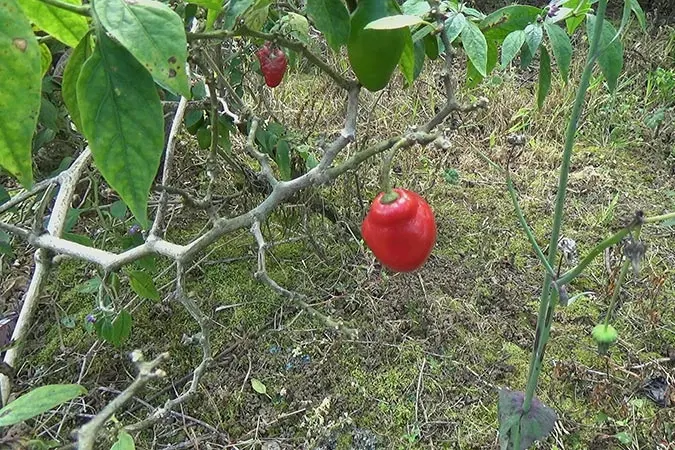Tree pepper (Capsicum pubescens) is a species of plant in the Solanaceae, a woody shrub or small tree, the leaf surface has hairs, the flowers are trumpet-shaped and purple in color, the ripe fruit is large and widely cultivated for fresh consumption and processed for various dishes.
C. pubescens grows as a shrub or as a small tree, upright stems up to four meters high but sometimes climbing, branches after 30 cm, woody with a light brown color but some varieties have purple discoloration on the branches and grow relatively fast and live up to 15 year.
Shoots develop from the leaf axils. The leaves have a stalk 5-12 mm long, ovate or elongated, hairy, 5-12 cm long, 2-4 cm wide, pointed tip, a bone in the middle with several lateral veins, the upper surface is green and the lower surface is pale.
Flowers appear singly or in pairs (rarely up to four) on the shoots, and the branches have a 1 cm long flower stem that extends on the fruit to 4-5 cm. The petals have five pointed triangular teeth, blue-purple in color with a bright color in the middle. The anthers are partially purple and white.
The fruit has a long stalk. The young fruit is round and dark green in color. Ripe fruit is elliptical in shape with rounded or tapered ends, bulging base and red.
Kingdom: Plantae
Phylum: Tracheophyta
Subphylum: Angiospermae
Class: Magnoliopsida
Order: Solanales
Family: Solanaceae
Subfamily: Solanoideae
Tribe: Capsiceae
Genus: Capsicum
Species: Capsicum pubescens
C. pubescens grows as a shrub or as a small tree, upright stems up to four meters high but sometimes climbing, branches after 30 cm, woody with a light brown color but some varieties have purple discoloration on the branches and grow relatively fast and live up to 15 year.
Shoots develop from the leaf axils. The leaves have a stalk 5-12 mm long, ovate or elongated, hairy, 5-12 cm long, 2-4 cm wide, pointed tip, a bone in the middle with several lateral veins, the upper surface is green and the lower surface is pale.
Flowers appear singly or in pairs (rarely up to four) on the shoots, and the branches have a 1 cm long flower stem that extends on the fruit to 4-5 cm. The petals have five pointed triangular teeth, blue-purple in color with a bright color in the middle. The anthers are partially purple and white.
The fruit has a long stalk. The young fruit is round and dark green in color. Ripe fruit is elliptical in shape with rounded or tapered ends, bulging base and red.
Kingdom: Plantae
Phylum: Tracheophyta
Subphylum: Angiospermae
Class: Magnoliopsida
Order: Solanales
Family: Solanaceae
Subfamily: Solanoideae
Tribe: Capsiceae
Genus: Capsicum
Species: Capsicum pubescens
